Water wheel generators for home power are renewable energy systems that harness flowing water to produce electricity. You'll find various types, including overshot, undershot, and Pelton wheels, each suited for different water sources. These systems consist of a wheel with paddles, a shaft, and a generator to convert mechanical energy into electrical power. They offer consistent, eco-friendly energy with low operational costs, but installation can be pricey. You'll need to evaluate legal requirements, maintenance, and your specific site conditions before implementing one. While they have limitations, water wheel generators can greatly boost your home's energy independence and reduce your carbon footprint. Dive deeper to explore if this centuries-old technology could power your modern home.
History of Water Wheel Generators
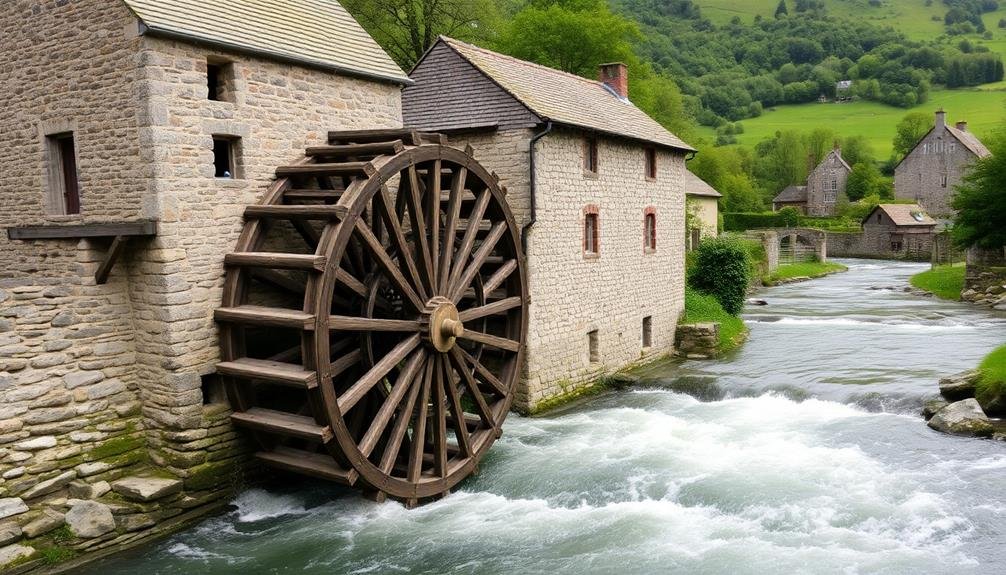
Harnessing the power of flowing water has been a cornerstone of human innovation for millennia. Water wheels, the precursors to modern hydroelectric generators, date back to ancient civilizations. The Greeks and Romans used them for irrigation and milling, while China employed water wheels for metallurgy as early as 30 BCE.
During the Middle Ages, water wheels became widespread in Europe, powering everything from flour mills to sawmills. The Industrial Revolution saw further advancements, with more efficient designs and materials improving their performance. In the late 19th century, the first hydroelectric power plants emerged, using water turbines to generate electricity.
You'll find that the concept of using water wheels for home power generation gained traction in the mid-20th century. As environmental concerns grew and energy costs rose, homeowners began exploring alternative energy sources.
Water wheel generators for residential use became more accessible, allowing people with access to flowing water to generate their own electricity.
Today, you can choose from various modern designs that blend traditional water wheel principles with advanced materials and efficient alternators, making home hydropower a viable option for those with suitable water resources.
Types of Water Wheel Generators
When you're considering a water wheel generator for your home, you'll find several types available, each suited to different water sources and power needs. The most common types are overshot, undershot, and breastshot wheels.
Overshot wheels are ideal for steep terrain with fast-flowing water. They're the most efficient, as water fills buckets at the top of the wheel, using both the water's weight and momentum to generate power. You'll need a good drop in elevation for this type.
Undershot wheels work well in flatter areas with faster currents. They're placed directly in the stream, with the flowing water pushing paddles at the bottom of the wheel. While less efficient than overshot wheels, they're easier to install and maintain.
Breastshot wheels are a middle ground option. Water enters at the wheel's midpoint, combining aspects of both overshot and undershot designs. They're versatile and can be used in various water conditions.
For smaller streams, you might consider a Pelton wheel. It uses high-pressure water jets directed at cups on the wheel's rim, making it efficient for low-flow, high-head situations.
Components of a Water Wheel
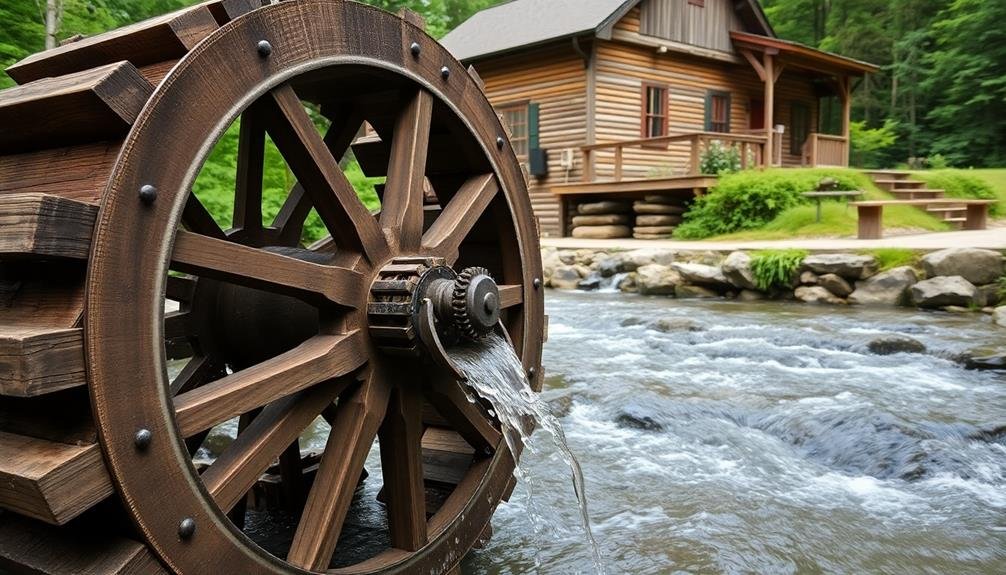
When you're building a water wheel generator, you'll need to focus on three main components.
First, consider the wheel and paddles, which capture the water's energy.
Next, you'll need a shaft and bearings to transfer the rotational motion, and finally, a generator and wiring system to convert the mechanical energy into electricity.
Wheel and Paddles
At the heart of a water wheel generator lies the wheel itself, along with its essential paddles. The wheel is typically made of durable materials like steel or heavy-duty plastic to withstand constant water exposure and rotational forces.
You'll find that wheel sizes can vary greatly, ranging from a few feet to over 20 feet in diameter, depending on the scale of your power generation needs.
The paddles, also called blades or buckets, are vital components attached to the wheel's rim. They're designed to catch the flowing water and convert its kinetic energy into rotational motion.
You'll see different paddle designs, including flat, curved, or cupped shapes, each ideal for specific water flow conditions. The number of paddles on a wheel can vary, but it's usually between 20 and 40.
When selecting a wheel and paddle configuration, you'll need to evaluate factors like water flow rate, available head (vertical drop), and desired power output.
The wheel's rotation speed is also important, as it affects the generator's efficiency. You may need to experiment with different paddle designs or wheel sizes to achieve the best performance for your specific site conditions.
Shaft and Bearings
How do you guarantee smooth and efficient operation of a water wheel generator? The shaft and bearings play a vital role in this process.
The shaft is the central axle that connects the wheel to the generator, transferring the rotational energy. You'll want to choose a sturdy, corrosion-resistant material like stainless steel for the shaft to assure longevity and minimal maintenance.
Bearings are equally important, as they reduce friction and support the shaft's rotation. You should opt for sealed, waterproof bearings to protect against moisture and debris.
Consider using self-lubricating bearings or implementing a reliable lubrication system to minimize wear and tear.
When installing the shaft and bearings, guarantee proper alignment to prevent vibrations and uneven wear. You'll need to securely mount the bearings to a stable foundation, allowing for easy maintenance access.
Regular inspections of the shaft and bearings are essential to detect any signs of wear or damage early on.
Generator and Wiring
What's the heart of a water wheel generator system? It's the generator itself, which converts the mechanical energy from the rotating shaft into electrical power.
You'll typically use a permanent magnet alternator (PMA) or a conventional alternator for this purpose. PMAs are often preferred for their efficiency and low maintenance requirements.
When selecting a generator, consider its power output, efficiency, and compatibility with your water wheel's rotational speed. You may need to incorporate a gearing system to match the generator's ideal RPM.
For wiring, you'll need to connect the generator to a charge controller, which regulates the power output and protects your batteries from overcharging. From there, wire the system to a battery bank for energy storage.
Include an inverter to convert the DC power from the batteries into AC power for household use. Ensure all wiring is properly sized, insulated, and protected from the elements.
Use waterproof connectors and junction boxes near the water wheel. Install a grounding system and circuit breakers for safety. Don't forget to include a disconnect switch for maintenance and emergencies.
How Water Wheels Generate Electricity
Water wheels harness the power of moving water to generate electricity. As water flows over or under the wheel, it pushes against paddles or buckets, causing the wheel to rotate. This rotational energy is then transferred to a generator through a shaft or gearing system.
The generator contains a rotor with powerful magnets that spins inside a stator lined with copper wire coils. As the rotor turns, it creates a changing magnetic field that induces an electrical current in the wire coils. This process, known as electromagnetic induction, is the key to converting mechanical energy into electrical energy.
You'll find that the amount of electricity generated depends on several factors: the volume and speed of water flow, the size and efficiency of the water wheel, and the capacity of the generator.
To maximize power output, you'll want to guarantee a consistent water supply and properly size your system to match your energy needs.
Modern water wheel generators often use advanced designs like Pelton wheels or crossflow turbines to improve efficiency. You can adjust the wheel's position or use multiple wheels to adapt to changing water levels and maintain consistent power generation throughout the year.
Advantages of Water Wheel Generators
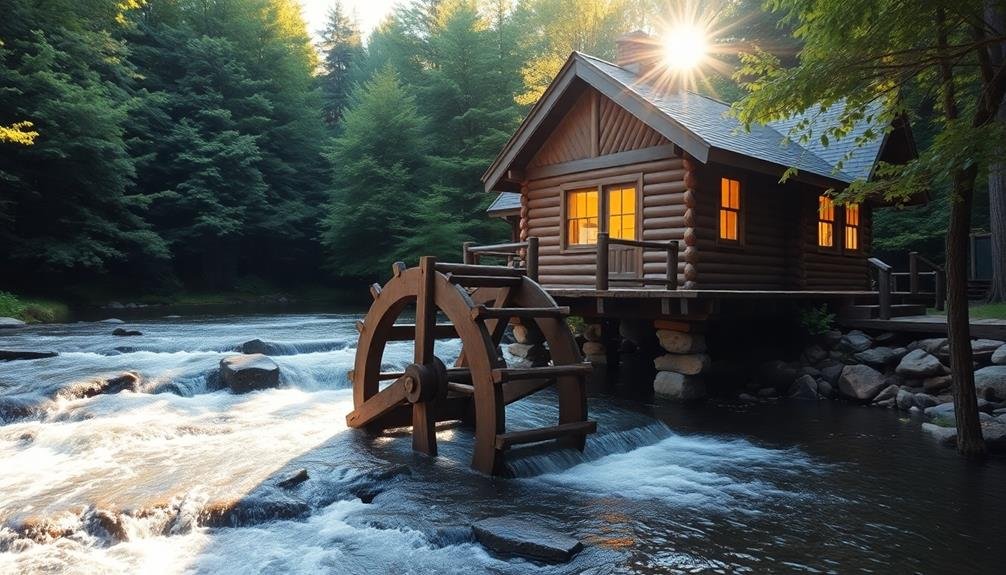
Home power generation's landscape is transformed by water wheel generators, offering numerous advantages. You'll find these systems provide a consistent and renewable energy source, harnessing the power of flowing water 24/7. Unlike solar panels, they're not affected by weather conditions or time of day, ensuring a steady power supply.
Water wheel generators are cost-effective in the long run. After the initial setup, they require minimal maintenance and have a long lifespan. You'll save on electricity bills and reduce your carbon footprint. They're also environmentally friendly, producing clean energy without harmful emissions.
These systems are scalable, allowing you to adjust the size based on your energy needs and available water flow. You can start small and expand later. They're quiet, unlike noisy gas generators, making them ideal for residential areas. Water wheel generators can be integrated with existing power systems, providing backup during outages or supplementing your main power source.
You'll appreciate their durability and resistance to extreme weather conditions. They're designed to withstand harsh environments, ensuring reliable performance year-round. With proper installation, water wheel generators offer a sustainable, efficient, and low-impact solution for home power generation.
Drawbacks of Water Wheel Generators
While water wheel generators offer eco-friendly power, they come with notable drawbacks you should consider.
You'll find their power generation capacity is often limited, potentially falling short of your household needs.
Additionally, you might face environmental impact concerns and high upfront installation costs, which can affect both your budget and local ecosystems.
Limited Power Generation
Despite their eco-friendly appeal, water wheel generators come with a significant drawback: limited power generation capacity. You'll find that these systems typically produce less electricity than other renewable energy sources like solar panels or wind turbines. This limitation stems from the nature of water wheels, which rely on the flow and volume of water to generate power.
The amount of electricity you can produce depends on various factors, including the size of your water source, the wheel's design, and the generator's efficiency. In most cases, you'll be able to power only a few small appliances or lights, rather than meeting your entire household's energy needs.
This limited output can be frustrating, especially if you're hoping to achieve energy independence. You might experience:
- Disappointment when realizing your system can't power high-energy devices
- Anxiety about choosing which appliances to prioritize
- Frustration during dry seasons when water flow decreases
- Concern over the cost-effectiveness of your investment
To overcome these limitations, you'll need to carefully assess your energy requirements and consider supplementing your water wheel generator with other power sources for a more reliable and thorough home energy solution.
Environmental Impact Concerns
Rippling waters may seem harmless, but water wheel generators can have unexpected environmental consequences. When you install a water wheel, you're altering the natural flow of a stream or river, which can disrupt local ecosystems. Fish and other aquatic life may struggle to navigate around the wheel, potentially impacting their migration patterns and breeding habits.
You'll also need to take into account the following environmental concerns:
| Impact Area | Potential Issues |
|---|---|
| Water Quality | Increased sedimentation, altered oxygen levels |
| Erosion | Changes in water flow leading to bank erosion |
| Wildlife | Disruption of habitats, barriers to movement |
| Vegetation | Altered water levels affecting riverside plants |
Additionally, the construction process itself can cause temporary disturbances to the surrounding area. You'll need to be mindful of local regulations and obtain necessary permits before installation. While water wheel generators can provide clean energy, it's essential to weigh their benefits against potential environmental costs. Think about consulting with environmental experts to assess the impact on your specific site and explore ways to minimize any negative effects.
High Installation Costs
Frequently, the high installation costs of water wheel generators catch homeowners off guard. While these systems can provide long-term energy savings, the initial investment can be substantial.
You'll need to take into account not only the cost of the generator itself but also expenses related to site preparation, water diversion, and professional installation.
The price tag for a complete water wheel generator system can range from $5,000 to $50,000 or more, depending on the size and complexity of the installation.
You'll also need to factor in ongoing maintenance costs and potential repairs. Before committing to this renewable energy option, it's essential to conduct a thorough cost-benefit analysis and evaluate your property's specific conditions.
Here are four emotional aspects to reflect on when facing high installation costs:
- Excitement about potential energy independence
- Anxiety over the significant upfront investment
- Frustration with unexpected additional expenses
- Pride in contributing to sustainable energy solutions
Despite the high initial costs, many homeowners find that water wheel generators offer long-term financial and environmental benefits.
However, you'll need to carefully weigh these advantages against the substantial upfront investment to determine if it's the right choice for your situation.
Site Assessment for Installation
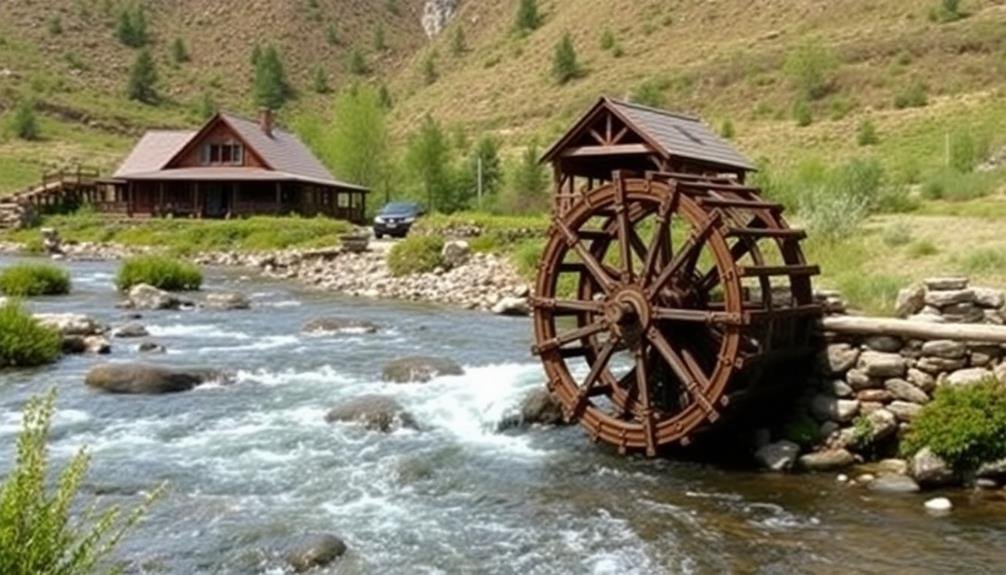
Before installing a water wheel generator, a thorough site assessment is essential. You'll need to evaluate several key factors to determine if your property is suitable for this type of renewable energy system.
First, assess the water source on your land. Measure the flow rate and head (vertical drop) of the stream or river, as these factors directly impact the potential power output of your generator.
Next, consider the distance between the water source and your home. Longer distances may require additional equipment and increase costs.
Evaluate the terrain and accessibility for construction equipment. You'll also need to account for seasonal variations in water flow and potential flood risks.
Don't forget to check local regulations and obtain necessary permits. Some areas have restrictions on water use or environmental concerns that could affect your project.
Consult with a professional hydro engineer to help you assess the site's potential and design an efficient system. They can also help you estimate power output and determine if a water wheel generator is economically viable for your specific location.
A thorough site assessment will guarantee you make an informed decision about investing in this renewable energy option.
Legal Considerations and Permits
Once you've determined your site's suitability, you'll need to navigate the legal landscape of water wheel generator installation. This process can be complex, as regulations vary by location and may involve multiple agencies.
Start by contacting your local planning department to inquire about zoning laws and building permits. You'll likely need to submit detailed plans and specifications for your project.
Next, consider water rights. In many areas, you'll need to obtain a water use permit from your state's water resources department. This guarantees you're not infringing on existing water rights or negatively impacting the environment.
Environmental agencies may require an assessment of your project's impact on local ecosystems, particularly fish populations.
To help you stay motivated during this potentially challenging process, remember these key benefits of water wheel generators:
- Clean, renewable energy that reduces your carbon footprint
- Potential for significant long-term cost savings on electricity bills
- Increased energy independence and resilience during power outages
- The satisfaction of harnessing nature's power in a sustainable way
Be prepared for potential pushback from neighbors or local conservation groups. Address their concerns proactively by demonstrating your commitment to responsible installation and operation.
Maintenance and Upkeep
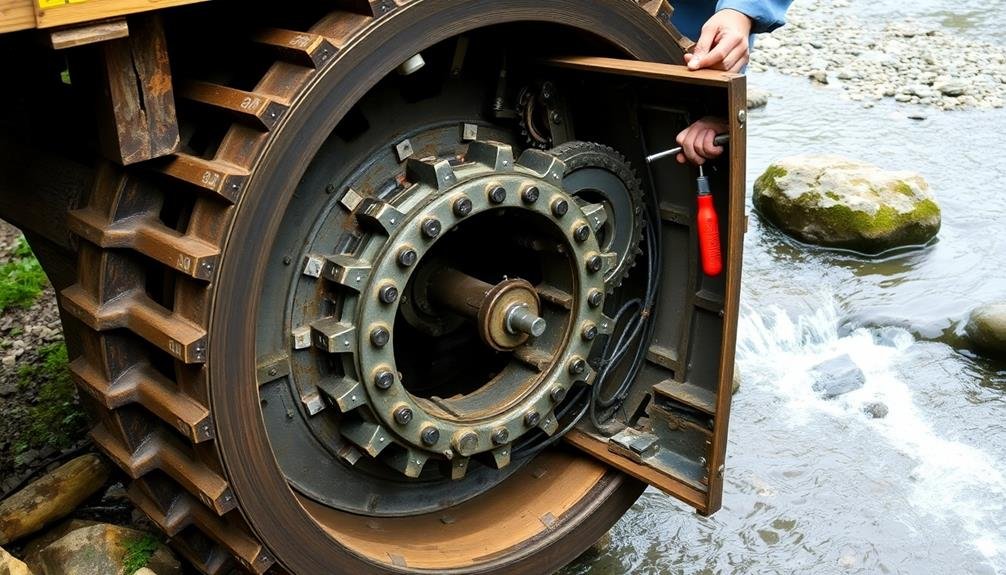
Maintaining your water wheel generator is vital for guaranteeing its longevity and peak performance. Regular inspections and cleaning are essential to prevent debris buildup and guarantee smooth operation. You'll need to check for wear on moving parts, such as bearings and gears, and replace them when necessary. It's also important to keep the generator's electrical components dry and protected from the elements.
Lubrication is key for reducing friction and preventing rust. Apply waterproof grease to bearings and other moving parts according to the manufacturer's recommendations. You'll also want to monitor water flow and adjust the wheel's position if necessary to maintain maximum efficiency.
Here's a quick maintenance checklist:
| Task | Frequency | Tools Needed |
|---|---|---|
| Debris removal | Weekly | Net, rake |
| Lubrication | Monthly | Grease gun |
| Bearing inspection | Quarterly | Flashlight, wrench |
Remember to keep detailed records of your maintenance activities and any issues you encounter. This will help you identify patterns and anticipate potential problems. If you're not comfortable performing maintenance yourself, consider hiring a professional to guarantee your water wheel generator continues to operate safely and efficiently.
Cost Analysis and ROI
While keeping your water wheel generator in top shape is important, it's equally essential to understand its financial implications. The initial investment for a water wheel generator can vary widely, depending on factors like size, materials, and installation complexity.
You'll need to take into account the cost of the wheel itself, the generator, and any necessary infrastructure modifications.
To determine your return on investment (ROI), calculate the energy savings over time. Compare your current electricity bills to the projected output of your water wheel generator. Don't forget to factor in maintenance costs and potential repairs. In many cases, you'll find that the long-term savings outweigh the initial expenses.
Here are four reasons why investing in a water wheel generator can be emotionally rewarding:
- Pride in energy independence
- Satisfaction of reducing your carbon footprint
- Peace of mind during power outages
- Joy of harnessing nature's power
When evaluating the cost analysis, remember that government incentives and tax credits may be available for renewable energy installations. These can greatly offset your initial investment and improve your ROI.
Additionally, some utility companies offer net metering programs, allowing you to sell excess electricity back to the grid, further enhancing your financial benefits.
Environmental Impact of Water Wheels
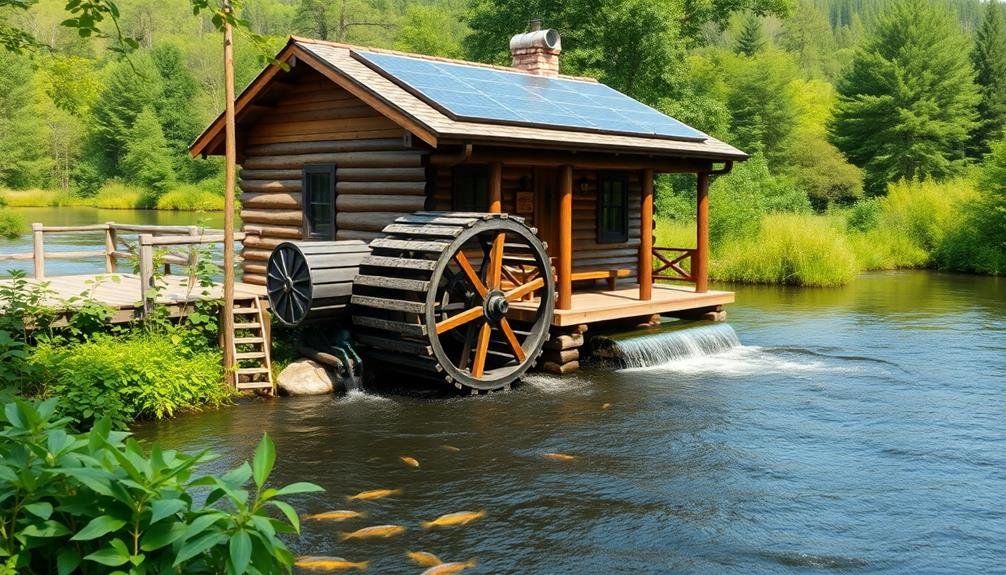
Water wheel generators can make a splash in the world of eco-friendly power solutions. These devices harness the natural flow of water to produce clean, renewable energy for your home. Unlike fossil fuel-based power sources, water wheels don't emit greenhouse gases or pollutants during operation, making them an environmentally conscious choice.
You'll find that water wheels have minimal impact on aquatic ecosystems when properly installed. They don't create barriers for fish migration like large-scale dams and don't alter water temperature or quality markedly. However, it's essential to take into account the potential effects on local wildlife and stream flow before installation.
Here's a comparison of water wheels' environmental impact with other power sources:
| Power Source | CO2 Emissions | Habitat Disruption | Noise Pollution | Water Usage |
|---|---|---|---|---|
| Water Wheel | Low | Minimal | Low | Low |
| Solar | Low | Moderate | None | Low |
| Wind | Low | Moderate | Moderate | None |
| Coal | High | High | High | High |
Frequently Asked Questions
Can Water Wheel Generators Work in Saltwater Environments?
Yes, you can use water wheel generators in saltwater environments. However, you'll need to choose corrosion-resistant materials and implement protective measures to prevent damage from salt. Regular maintenance is essential to guarantee peak performance and longevity in these conditions.
How Noisy Are Water Wheel Generators During Operation?
You'll find water wheel generators are generally quiet during operation. They produce a gentle, soothing sound of flowing water. However, larger systems or those with metal components might create some mechanical noise. It's typically not disruptive to homeowners.
Are There Portable Water Wheel Generators for Camping or Emergency Use?
You'll find portable water wheel generators for camping and emergencies. They're compact and easy to set up in streams or rivers. You can use them to charge devices or power small appliances. They're eco-friendly and don't need fuel.
Can Water Wheel Generators Be Integrated With Other Renewable Energy Systems?
You can integrate water wheel generators with other renewable systems. They complement solar panels and wind turbines well. You'll create a more diverse and reliable energy mix, enhancing your home's sustainability and reducing reliance on the grid.
Do Water Wheel Generators Affect Fish Populations in Streams or Rivers?
You'll find that water wheel generators can impact fish populations. They may disrupt migration patterns, injure fish passing through, or alter stream flow. However, modern designs often include fish-friendly features to minimize these effects on aquatic life.
In Summary
You've learned about water wheel generators for home power, from their history to their environmental impact. These systems can provide clean, renewable energy for your home if you have access to flowing water. While they require initial investment and ongoing maintenance, water wheels offer long-term savings and sustainability. Before installing one, you'll need to evaluate legal requirements and environmental factors. With proper care, a water wheel generator can be a valuable addition to your home's energy system.

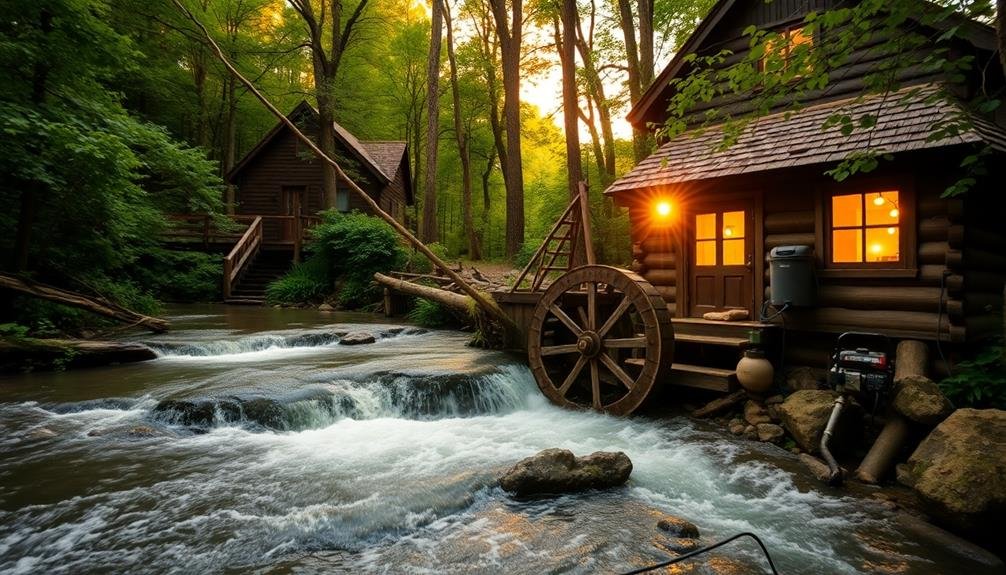

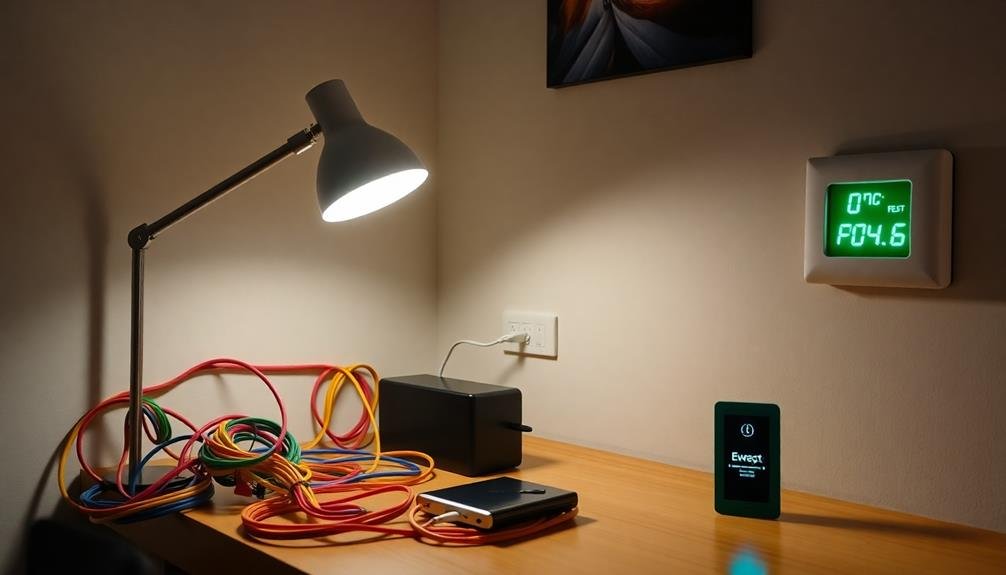

Leave a Reply